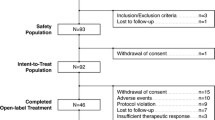Abstract
Objective: In this open-label, non-randomised, 12-week, retrospective comparative study, the efficacy and tolerability of benzatropine (benztropine) and terazosin were assessed in patients diagnosed with schizophrenia or a related psychotic disorder who were treated with clozapine and subsequently began to experience hypersalivation within 1 month.
Methods: Sixty clinic charts were reviewed. All patients were from long-term care facilities. Patients were randomly assigned to four treatment groups: (a) no treatment; (b) treatment with benzatropine 1mg twice daily; (c) treatment with terazosin 2mg once daily, at night-time; and (d) treatment with benzatropine and terazosin according to the same scheme as in (b) and (c). Clozapine dosages in these four groups were 100mg to 700mg daily (average 325mg daily). The primary target symptom (hypersalivation) was assessed and recorded by open questioning at baseline and at weeks 1, 4 and 12.
Results: The primary efficacy end-point was a comparison of the change of hypersalivation in patients’ response in the four treatment groups from baseline to week 12. All the changes were statistically significant (p < 0.001). However, treatment with benzatropine and terazosin together was more effective. Use of this combined therapy in the management of hypersalivation resulted in a 100% satisfactory response vs 66.7% of patients on benzatropine, and 93.3% of patients on terazosin. Compliance with medication was 100% and no significant adverse events were observed. The most common adverse events reported by patients were constipation, dizziness and drowsiness. However, these did not present a valid reason for discontinuation of the benzatropine and terazosin therapy during clozapine-induced hypersalivation.
Conclusion: The results of this retrospective study demonstrated that terazosin was an effective and well tolerated drug in the management of a very common adverse effect of clozapine therapy, namely, hypersalivation. The combination of benzatropine and terazosin provided consistently superior response rates to either therapy alone.
Similar content being viewed by others
References
Snyder S, Greenberg D, Yamamura H. Antipsychotic drugs and brain cholinergic receptors: affinity for muscarinic sites predicts extrapyramidal effects. Arch Gen Psychiatry 1974; 31: 58
Miller RJ, Hiley CR. Antimuscarinic properties of neuroleptics and drug-induced parkinsonism. Nature 1974; 248: 596–7
Bolden C, Cusack B, Richelson E. Clozapine is a potent and selective muscarinic antagonist at the five cloned human muscarinic acetylcholine receptors expressed in CHO-K1 cells. Eur J Pharmacol 1991; 192: 205
Meltzer H, Chai B, Thompson P, et al. Effect of scopolamine on the efflux of dopamine and its metabolites after clozapine, haloperidol or thioridazine. J Pharmacol Exp Ther 1994; 268: 1452
Rivest R, Marsden C. Muscarinic antagonists attenuate the increase in accumbens and striatum dopamine metabolism produced by clozapine but not by haloperidol. Br J Pharmacol 1991; 104: 234
Zorn S, Jones S, Ward K, et al. Clozapine is a potent and selective muscarinic M4 receptor agonist. Eur J Pharmacol 1994; 269(3): R1–2
Tandon R, Kane JM. Neuropharmacologic basis for clozapine’s unique profile. Arch Gen Psychiatry 1993; 50: 158–9
Bolden C, Cusack B, Richelson E. Antagonism by antimuscarinic and neuroleptic compounds at the five cloned human muscarinic cholinergic receptors expressed in Chinese hamster ovary cells. J Pharmacol Exp Ther 1992; 260: 576–80
Cohen B, Lipinski J. In vivo potencies of antipsychotic drugs in blocking A1 noradrenergic and dopamine D2 receptors: implications for drug mechanism of action. Life Sci 1986; 39: 2571–80
Breier A. Clozapine and noradrenergic function: support for a novel hypothesis for superior efficacy. J Clin Psychiatry 1994; 55: 9 Suppl. B: 122–5
Lieberman J, Safferman A. Clinical profile of clozapine: adverse reactions and agranulocytosis. Psychiatry Q 1992; 62: 51–70
Mandel J, Zengo A, Katz R, et al. Effect of adrenergic agents on salivary composition. J Dental Res 1975; 54 [Special issue]: B27–B33
Ukai Y, Taniguchi T, Kimura K. Muscarinic supersensitivity and subsensitivity induced by chronic treatment with atropine and disopropylfluorophosphonate in rat submaxillary glands. Arch Int Pharmacodyn Ther 1989; 297: 148–57
Dev V, Krupp P. Adverse event profile and safety of clozapine. Pharmacotherapy 1995; 6: 197–208
Frankenburg FR. Clozapine update. Tufts University School of Medicine Ninth Annual Psychopharmacology Update; Oct 12, 1991
Author information
Authors and Affiliations
Rights and permissions
About this article
Cite this article
Reinstein, M.J., Sirotovskaya, L.A., Chasanov, M.A. et al. Comparative Efficacy and Tolerability of Benzatropine and Terazosin in the Treatment of Hypersalivation Secondary to Clozapine. Clin. Drug Investig. 17, 97–102 (1999). https://doi.org/10.2165/00044011-199917020-00003
Published:
Issue Date:
DOI: https://doi.org/10.2165/00044011-199917020-00003




